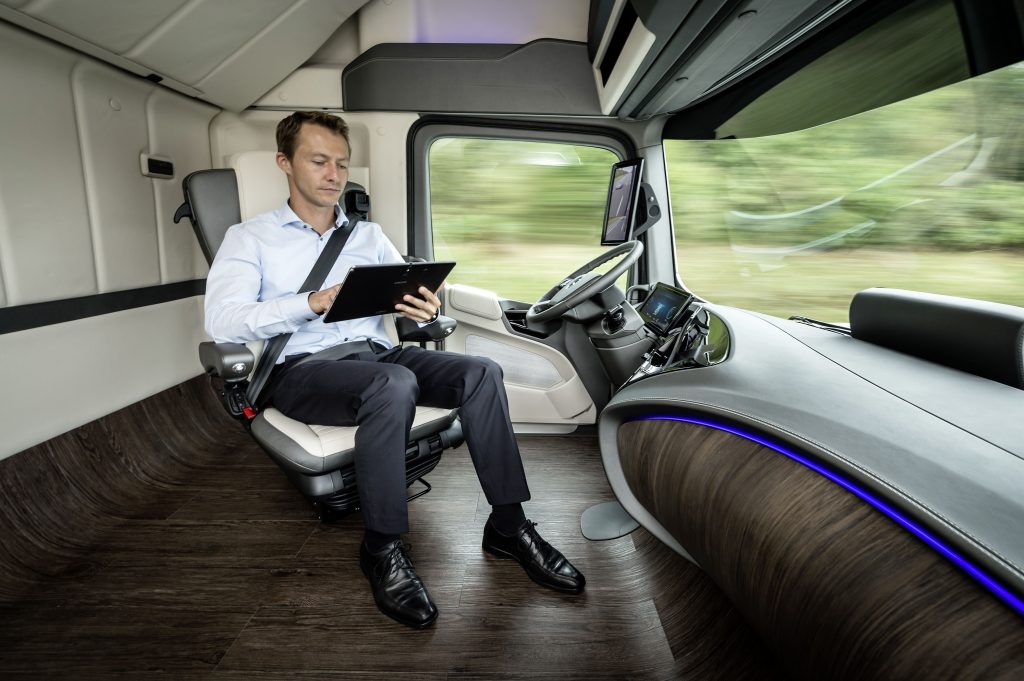 As driving and park-assist technology becomes more prevalent in trucks today, experts look ahead to what a future with self-driving trucks would mean for logistics and the automotive supply chain.
As driving and park-assist technology becomes more prevalent in trucks today, experts look ahead to what a future with self-driving trucks would mean for logistics and the automotive supply chain.
Driverless cars entered the public imagination in force several years ago, when the media started following the development of the self-driving Google Car. Since then, several OEMs have promised that autonomous passenger cars will be on the road by 2020. While media attention remains on passenger cars, a growing number of truck manufacturers, suppliers, logistics providers and start-up companies are also investigating the potential of driverless vehicle technology for trucks and the logistics sector.
Some aspects of the technology used to power driverless trucks are already in the marketplace, including bumper sensors, radar cameras and positioning guidance. Some vehicles can already be controlled without drivers in closed loops or private facilities. In 2014, for example, ZF revealed a 25 metre (80ft) long ‘Innovation Truck’ that can be driven with one finger and an app on a smartphone or tablet. The function is intended for manoeuvres into small spaces and parking rather than motorways. When it reaches a depot, the truck is handed over to a dispatcher, who uses the tablet to manoeuvre it outside the cab, while the truck is powered only by its battery. Drivers can begin their rest period upon arrival.
Such uses of automation or part-automation are increasing, while there is also ongoing research into using driverless trucks on motorways and in cities. This interest comes partly as a result of driver shortages in many countries, as well as rising logistics costs. The prospect of automating parts of driver labour could save money, while reducing accidents.
There are other interesting prospects for supply chains, including for automotive, beyond reducing driver costs. A truck with some or all of its driving functions automated would allow other operations even while material is on the road, such as inspections, unpacking or even kinds of assembly. Dr Helmut Wlcek, a consultant at Logistics Innovations, who is researching such technology for Germany’s Robert Bosch as well as DHL, believes such automation could increase the potential for long distance, just-in-time logistics operations.
Such scenarios are still a long way off; even if technology might permit it, many regulations currently would not. But the logistics industry is gliding towards further automation.
Platoons and road trains
The definition of self-driving, autonomous, or driverless vehicles vary somewhat between the degree to which operation occurs without direct driver input to control the steering, acceleration, and braking. Carola Pfeifle, product communications manager at Mercedes-Benz Trucks describes autonomous driving as the “independent, targeted operation of a vehicle under real-life traffic conditions without the intervention of a human driver.”
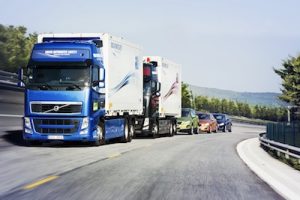
"The basis of SARTRE is to have a lead vehicle, in our case a truck, with a skilled, specially licenced driver that is supported by all available support systems as a lead vehicle," says Carl Johan Almqvist, traffic and product safety director at Volvo Trucks.
"You could envision it like letting the lead vehicle lay out a trail of bread crumbs that is followed by all the trailing vehicles," he adds.
According to Almqvist, most of the hardware required to operate the platoon was already available in the Volvo trucks used in the project, including a forward-facing radar and camera used in the collision warning and emergency brake system, as well as a dynamic steering system. The only technology the project team added was a Wi-Fi connection so that when the lead driver used the brakes, they were applied along the whole platoon.
"The advantage of trailing at short distances, down to a gap of four metres, is the gain in traffic safety, since 90% of all accidents are due to driver error,” says Almqvist. “Fuel consumption is also a key issue as there are fuel gains to be made by both the lead vehicle and the trailing vehicles."
The tests for SARTRE were performed mainly on Volvo’s own proving ground but the project also gained permission for tests on Spanish roads with two trucks and three cars.
Following positive results from SARTRE, Volvo Trucks has been developing its own driverless truck and equipment technology. "We are running research projects within Volvo Construction equipment with wheel-loaders that can support a production facility, for example by loading woodchips into a paper mill,” says Almqvist.
Earlier this year, the UK Department for Transport announced its support for research to understand how platooning technology might be used to benefit UK businesses, the transport network, road safety and the environment. The project, which is also led by Ricardo, alongside a consortium comprising the Transport Research Laboratory and Transport and Travel Research, will investigate issues faced by legislators, haulage companies, drivers of the vehicles in the platoon, trunk road network operators and other road users, to establish whether trials of a heavy goods vehicle platoon should be considered.
Peter Gilhead, senior project engineer at Ricardo believes platooning is probably the main area of interest for trucks in the shorter term, with studies showing the technique can improve fuel efficiency and safety.
"Improved safety by reducing the opportunity for driver error through loss of attention and tiredness could eventually reduce insurance premiums once such systems have become more established," he adds.
'V2V' coordination
Much of the technology required for these systems, including adaptive cruise control, lane-keeping assist, collision avoidance and parking-assist, is already available, particularly in passenger cars. Although some of this technology is relevant to trucks, Gilhead highlights that the main emphasis for passenger cars is generally related to improving driver comfort, whereas in trucks the emphasis is on fuel consumption, safety and labour hours.
"For haulage operators there may be more opportunities for this kind of technology to be introduced earlier in specific environments, such as ports and airports where vehicle routes are more controlled and restricted," he says.
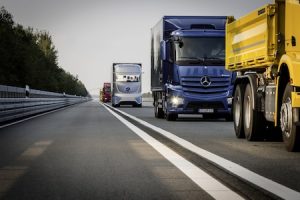
US-based Peloton Technology is also championing a platooning system that uses technology to augment the ability of the human driver. Joshua Switkes, founder and CEO at Peloton, says the system uses sensors and vehicle-to-vehicle (V2V) communications to prevent crashes and increase the efficiency of trucks.
"We see drivers as a resource. They typically drive well over 100,000 miles (160,000km) per year, and so we plan to build on that experience and expertise rather than throwing it away," he says.
The system uses on-board technology to sense obstacles ahead of the front truck and automatically apply the brakes if needed. This automatic reaction is then extended to a rear truck, through V2V communication, effectively coupling the vehicles so that whatever the front truck does, the rear one does it nearly simultaneously. The system controls only the gas and the brake, with the steering left to the driver. Similarly to the Volvo project, the trucks can be driven much closer to one another than usual.
"A human driver takes one or two seconds to react to an obstacle ahead, whereas our system makes the braking nearly simultaneous between the two trucks. With this in place, we can safely put the trucks much closer together than what would normally be safe," says Switkes.
The closer distance has design implications that lead to dramatically improved aerodynamics, with potential to save more than 10% fuel. On an initial fleet test with CR England, based out of Utah, Peloton measured 10% savings on the rear truck and 4.5% on the front truck, according to Switkes.
Daimler’s 2025 truck
There are other projects looking more specifically at autonomous, individual trucks. In July 2014, Daimler Trucks successfully demonstrated the capabilities of its ‘Future Truck 2025’ on a section of motorway in Magdeburg, Germany. The truck features an on-board highway pilot system, which resembles the autopilot system on an aeroplane, and enables it to drive autonomously up to 80kmph in realistic traffic situations. According to Daimler’s Carola Pfeifle, the innovation is “a key component of the transport system of the future”.
"[It] is sparing on resources, reduces emissions of all types, ensures maximum road traffic safety and increases the level of networking in road transport. Goods traffic in the future will be safer, more efficient and more connected as a result," she says.
For her, the innovation marks a revolution for all aspects of road logistics. "The Future Truck 2025 does not need to be daisy-chained to other vehicles. Radar sensors and camera technology enable it to drive autonomously, independently of other vehicles or central control stations," she says.
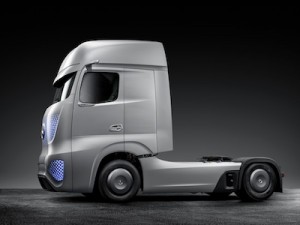
The system includes a three-dimensional digital map to which the truck follows and reacts. "The truck is always fully aware of the road's course and topography, with a resulting positive effect on fuel consumption," adds Pfeifle.
Pfeifle predicts the truck could enhance the driver job profile rather than eliminate it, as drivers would be able to perform new logistics tasks even while on the road, which would create more efficient logistics in terms of scheduling and route planning.
"Autonomous driving will transform the entire transport logistics sector. Job orders and consignee addresses will be sent directly to the vehicle, and vehicle connectivity will enable much more precise route calculations,” predicts Pfeifle. “The resulting improved flow of traffic alone will lead to an increase in average transport speed, without having to increase the speed limit for trucks. All participants in freight forwarding operations will benefit.”
Reshaping the automotive supply chain – without a driver
Tier supplier and technology firm Robert Bosch is also involved in the development of autonomous driving for passenger cars, and is investigating whether the technology can be transferred to logistics applications. Dr Helmut Wlcek, who is the ex-head of corporate logistics at Bosch, is currently working with the firm to help it gain further understanding of the potential for automation in the sector.
"I am identifying business cases in logistics where autonomous driving – no matter if inside facilities, long haul or last mile – can be used, and what market potential there is,” he says. “Furthermore I am trying to understand long-term impacts of autonomous vehicles on the business environment, such as to trucking companies, logistics service providers and trade.”
"By reducing [truck driving] cost, a new trade-off between local and remote production will be created, as well as a new trade-off for shipment quantity versus shipping frequency" - Dr Helmut Wlcek, Logistics Innovations
Wlcek is also working alongside DHL Innovations on a report focusing on autonomous driving in logistics applications. The report provides an overview on the current state of autonomous driving in general, and outlines future business cases for autonomous driving in logistics.
"The benefits of automated driving will be huge – it is much more convenient for the drivers, it enables mobility for people who are not able to drive, like children, elderly or handicapped people,” says Wlcek. “It will dramatically reduce the number and severity of accidents and reduce traffic jams.”
Wlcek also predicts that driverless trucking will make transport cheaper, as one of the biggest cost drivers, the salary of the driver, is replaced by automation. This would impact not only logistics operations as well as material sourcing locations. “By reducing this cost, a new trade-off between local and remote production will be created, as well as a new trade-off for shipment quantity versus shipping frequency," he adds.
Wlcek suggests that driverless trucks will be able to drive further, since an automated system does not need rest breaks. He predicts that high frequency JIT deliveries will be able to be implemented over longer distances.
Driving through legal mazes
For Wlcek, many technological challenges remain before companies will be able to get automated trucking up and running safely – and he points out that there will be a need for new services for road assistance and safety for driverless trucks.
Furthermore, he suggests that supply chain managers will have to redesign processes and systems in such a way as to take advantage of such technology. "Specific challenges for the automotive logistics sector will relate to how to use the advantages of autonomous transportation in an intelligent way by adapting the current supply chains concerning their design, structure, and parameters, [including] transport frequencies and safety stocks," he says.
Daimler’s Pfeifle points to the ongoing need to meet functional safety requirements, which she says will be achieved by collecting data from different sensor technologies over long distances, to enable safe autonomous driving in complex scenarios.
Pfeifle argues that vehicle registration laws will have to be adapted in line with the latest technology. While it's already possible to register an automated vehicle, international regulations on steering equipment do not officially permit automated steering above 10kmph, except for corrective purposes. A revision process is already under way and will likely be completed in three to four years, she adds. However there are many other regulations and laws that will need to be adjusted. “Before these initiatives have any impact, regulatory laws will be met by ensuring that only partially autonomous solutions are implemented and that drivers can continually monitor the associated systems," she adds.
"Before these initiatives have any impact, regulatory laws will be met by ensuring that only partially autonomous solutions are implemented and that drivers can continually monitor the associated systems" - Carola Pfeifle, Daimler Trucks
Wlcek says that a regulatory turning point would come in recognising automated periods as part of mandatory rest breaks, which so far is not the case since the driver needs to be ready to intervene. “Acceptance of break-time [during automated driving] would be the first big step to making automation in trucking interesting from an economical point of view.”
There are many other legal webs to untangle. Volvo’s Almqvist wonders who might be responsible if something goes wrong with a driverless system – the driver, the owner, the manufacturer or the road authority? He also highlights the potential difficulties of persuading the general public to accept the technology. "Take the example of a modern aeroplane: it can take off, fly, land and taxi to the gate without any help from a human hand,” he points out. “Would you like to be on-board that plane without a pilot up front? Maybe not today but in 10-20 years, this might be normal procedure.”
Before society is entirely comfortable with the idea of autonomous driving, Pfeifle believes the industry must first demonstrate the advantages it offers, including enhanced road safety, greater comfort for drivers, and greater economy and profitability.
Technical systems must be improved, and most importantly, trust in the technology must be established. “That's the only way to stimulate demand for autonomous vehicles among our customers and gain acceptance from the public at large. This will persuade politicians and put pressure on them to act. Vehicle manufacturers, politicians and government officials must work hand in hand here in a gradual process," she says.
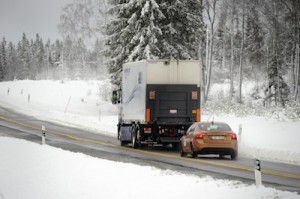
Most experts still don’t foresee fully automated trucks on the roads for some time. Almqvist believes that most uses will remain in restricted areas such as ports and plants, with road trains the most likely to be adapted on a wider scale. “I'm sure you could use driverless technology in a port where trucks carrying containers come in for loading and unloading," he says. "Platooning could also be easier to implement as you don’t have to have all the roads and infrastructure in place as for autonomous driving."
Peloton’s Switkes predicts that more driver assistance systems will be used to help truck drivers to avoid accidents and to reduce fuel consumption. "For commercial vehicles a tremendous cost saving can be had from preventing accidents and reducing fuel use," says Switkes.
On the other hand, full automation on motorways could take 15-20 years or more, and perhaps even longer for cities. “Nobody knows when it will happen,” Wlcek admits.



































